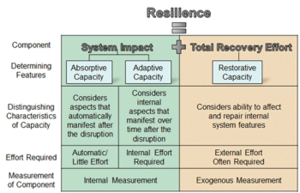ResilienceSandia to help cities be better prepared for, emerge stronger from, disasters
Sandia National Laboratories says it will bring its experience solving problems with practical engineering and modeling complex systems to cities around the world under a new agreement to support the 100 Resilient Cities Centennial Challenge, pioneered by the Rockefeller Foundation. The challenge, which will help thirty-three cities in its first year, seeks to make communities more resilient by being better prepared to withstand natural or manmade disasters, recover more quickly, and emerge stronger.

Flowchart of Sandia Lab's resiliency model // Source: sandia.gov
Sandia National Laboratories says it will bring its experience solving problems with practical engineering and modeling complex systems to cities around the world under a new agreement to support the 100 Resilient Cities Centennial Challenge, pioneered by the Rockefeller Foundation.
The challenge, which will help thirty-three cities in its first year, seeks to make communities more resilient, by being better prepared to withstand natural or manmade disasters, recover more quickly, and emerge stronger.
“We are eager to partner with the 100 Resilient Cities Centennial Challenge,” said Jill Hruby, vice president of International, Homeland, and Nuclear Security at Sandia, who signed the memorandum of understanding. “We see this as an opportunity to bring the best minds in science and engineering to help people around the world recover from the shocks and stresses of modern threats and times.”
Michael Berkowitz, managing director for 100 Resilient Cities at the Rockefeller Foundation and the CEO of the 100 Resilient Cities Centennial Challenge, said, “We’re excited to welcome Sandia National Laboratories as the newest partner to the 100 Resilient Cities platform, and for them to begin offering 100 Resilient Cities network members Sandia’s technical expertise in developing risk assessments, modeling complex systems and finding innovative engineering solutions that can help cities build resilience.”
Five-year partnership to bring framework of best practices to cities
Sandia Labs has developed resilience methodologies, models and other tools which could be used to create a resiliency framework based on best practices worldwide, but adapted to cities’ individual needs, said Charles Rath, project lead for Sandia Labs.
“The ultimate goal is to improve global stability by kick-starting a worldwide resiliency movement,” he said. “We want to use this experience to develop models and best practices that can be shared with cities across the world.”
Under the five-year memorandum, Sandia will supply cities with a toolkit of infrastructure and socio-economic models that will help local leaders better assess specific resilience challenges, set priorities and select the most cost-effective ways to address them.
“Sandia’s experts have deep knowledge in how to address nearly every challenge a city might face — everything from how to make its energy grid more resilient to how to achieve a more clean and sustainable water supply,” Rath said.
Among Sandia’s experts who will work with cities are Trisha Miller, a Sandia systems risk analyst, Abraham Ellis, an electrical grid expert, and Sandia hydrologist Vince Tidwell.
